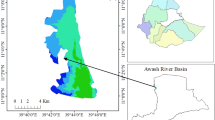Abstract
Groundwater is a major source of water for agricultural and domestic requirements in western Uttar Pradesh. Due to increasing agricultural requirements the abstraction of groundwater has increased manifold in the last two-to-three decades. The quaternary alluvium hosts the aquifer in the region. The study area forms a part of Yamuna-Krishni interfluve. Although the area hosts potential aquifers these have been adversely affected by poor management. For effective groundwater management of a basin it is essential that a careful water balance study should be carried out. Keeping this in mind groundwater flow modelling was attempted to simulate the behaviour of the flow system and evaluate the water balance. The groundwater flow modelling was carried out. The horizontal flows, seepage losses from unlined canals, recharge from rainfall and irrigation return flows were applied using different boundary packages available in Visual MODFLOW, Pro 4.1. The river-aquifer interaction was simulated using the river boundary package. Hydraulic conductivity values were applied to specific zones and these ranged from 9.8 to 26.6m/day. Recharge due to rainfall and irrigation returns were assigned to respective zones. Pumping rates of 500m3/day, 1000m3/day, 1500m3/day, 2000m3/day and 2500m3/day were applied to appropriate areas of the model to simulate areas of stress. The zone budget shows a water balance deficit for the period June 2006 to June 2007. The total recharge to the study area is 160.21 million m3 (Mcum). The groundwater draft through pumping is of the order of 233.56 Mcum, thus leaving a deficit balance of −73.35 Mcum. The sensitivity of the model to input parameters was tested by varying the parameters of interest over a range of values, monitoring the response of the model and determining the root mean square error of the simulated groundwater heads to the measured heads. These analyses showed that the model is most sensitive to hydraulic conductivity and recharge parameters. Three scenarios were considered to predict aquifer responses under varied conditions of groundwater bstraction.
Similar content being viewed by others
References
Ahmed I and Umar R 2008 Hydrogeological framework and water balance studies in parts of Krishni-Yamuna interstream area, western Uttar Pradesh, India. J. Environ. Geol. 53(8) 1723–1730.
Ala Eldin M E H, Ahmed M S, Gurunadha Rao V V S and Dhar R L 2000 Aquifer modeling of the Ganga-Mahawa sub-basin, a part of the Central Ganga Plain, Uttar Pradesh; India. Hydrol. Process. 14 297–315.
Anderson M P and Woessner W W 1992 Applied groundwater modeling; Academic Press, San Diego.
Anderson M P and Woessner W W 2002 Applied groundwater modeling — Simulation of flow and advective transport.
Bhatnagar N C, Agashe R M and Mishra A K 1982 ’Subsurface Mapping of Aquifer System’ Water balance study of Upper Yamuna Basin, Section-Hydrogeology, Technical report No. 2, Upper Yamuna Project, CGWB, NW region, Chandigarh.
Gupta C P, Thangarajan M and Rao V V S G 1979 Electrical analog model study of aquifer in Krishni-Hindon interstream region, Uttar Pradesh, India; Groundwater 17(3) 284–292.
Gupta C P, Ahmad S and Rao V V S G 1985 Conjunctive utilization of surface water and groundwater to arrest the water level decline in an alluvial aquifer; J. Hydrol. 76(3/4) 351–361.
Healy R W and Cook P G 2002 Using groundwater levels to estimate recharge; J. Hydrogeol. 10(1) 91–109.
Hsu K C, Wang C H, Chen K C, Chen C T and Ma K W 2007 Climate-induced hydrological impacts on the groundwater system of the Pingtung Plain, Taiwan; J. Hydrogeol. 15(5) 903–913.
Jyrkama M I, Skyes J F and Normani S D 2002 Recharge estimation of transient groundwater modeling; Groundwater 40(6) 638–648.
Kennett-Smith A, Narayan K and Walker G 1996 Calibration of a groundwater model for the upper south east of South Australia. Div. report 96-2. CSIRO Division of Water Resources, Canberra, Australia.
Khan A M 1992 Report on systematic hydrogeological surveys in parts of Muzaffarnagar District, U.P., Central Groundwater Board, Northern Region, Lucknow, India.
Kumar S 1994 Report on Hydrogeological and Groundwater Resources Potential, Muzaffarnagar Districts, U.P. Central Ground Water Board, Northern Region, Lucknow.
McDonald M G and Harbaugh A W 1988 A modular three dimensional finite-difference groundwater flow model. USGS Open File Report 83-875. USGS, Washington, D.C.
Ministry of Water Resources 1997 Report of the groundwater resource estimation committee — Groundwater resource estimation methodology, Government of India, New Delhi.
Onta P R, Dasgupta A and Harbor R 1991 Multistep planning model for conjunctive use of surface-water and groundwater resources; J. Water Resources Planning and Management 117(6) 662–678.
Reichard E G 1995 Groundwater surface water management with stochastic surface water supplies — A simulation optimization approach; Water Resources Research 31(11) 2845–2865.
Rushton K 2006 Representation in regional models of saturated river-aquifer interaction for gaining losing rivers; J. Hydrol. 334 262–281.
Senthil Kumar M and Elango L 2004 Three dimensional mathematical model to simulate groundwater flow in the lower Palar River basin, southern India; J. Hydrogeol. 12(3) 197–208.
Umar R 2008 Groundwater Flow Modeling and Aquifer Vulnerability Assessment studies in Yamuna-Krishni sub-basin, Muzaffarnagar District, Ministry of Water Resources, Government of India (Unpublished progress report), 51p.
Varni M R and Usunoff E J 1999 Simulation of regional scale groundwater flow in the Azul River Basin, Buenos Aires province, Argentina; J. Hydrogeol. 7(2) 180–187.
Wang C C, Mortazavi B, Liang W K, Sun N Z and Yeh W W G 1995 Model development for conjunctive use study of the San Jacinto Basin, California; Water Res. Bull. 31(2) 227–241.
Waterloo Hydrogeologic Inc. 2005 Visual MODFLOWv.4.1, User’s Manual, Waterloo, Ontario, Canada.
Woessner W W 2000 Stream and fluvial plain groundwater interactions: Rescaling hydrogeologic thought; Groundwater 38(3) 423–429.
Author information
Authors and Affiliations
Corresponding author
Rights and permissions
About this article
Cite this article
Ahmed, I., Umar, R. Groundwater flow modelling of Yamuna-Krishni interstream, a part of central Ganga Plain Uttar Pradesh. J Earth Syst Sci 118, 507–523 (2009). https://doi.org/10.1007/s12040-009-0050-5
Received:
Revised:
Accepted:
Published:
Issue Date:
DOI: https://doi.org/10.1007/s12040-009-0050-5




